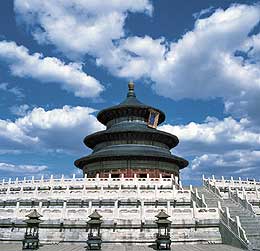Temple of Heaven
The Temple of Heaven (天坛), literally the Altar of Heaven, is a complex of Taoist buildings situated in southeastern Beijing. The Emperors of the Ming and Qing dynasties visited the complex annually when they prayed to Heaven for good harvests. It is regarded as a Taoist temple, although Chinese Heaven worship, especially by the reigning monarch of the day, actually pre-dates Taoism.
The temple complex was constructed from 1406 to 1420 during the reign of the Yongle Emperor, who was also responsible for the construction of the Forbidden City in Beijing. The complex was extended and renamed the Temple of Heaven during the reign of the Jiajing Emperor in the 16th century. The Jiajing Emperor also built three other prominent temples in Beijing, the Temple of the Sun in the east, the Temple of the Earth in the north, and the Temple of the Moon in the west. The Temple of Heaven was renovated in the 18th century under the Qianlong Emperor.
In 1914, Yuan Shih-kai, then President of the Republic of China, performed a Ming prayer ceremony at the temple, as part of an effort to have himself declared Emperor of China.
The Temple of Heaven was registered on the UNESCO World Heritage List in 1998.
